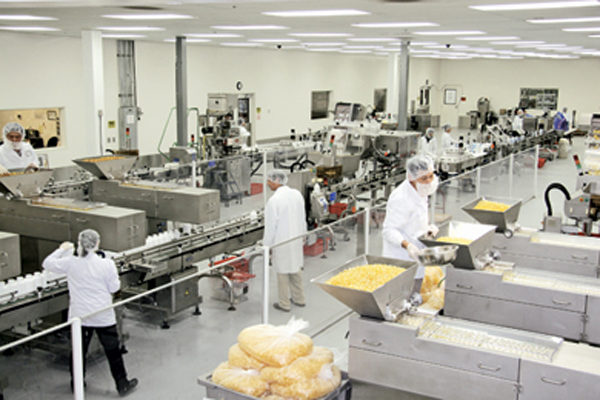Bottle packaging lines. Photo supplied by Robinson Pharma.
Contract manufacturing. Did reading that phrase make you picture a buzzing room filled with shiny silver equipment? Or, did you envision a team of innovators that can help you turn an idea into reality (or an established product into something even better)? Well, the latter is closer to what contract manufacturing today is all about.
A good contract manufacturer can be with you every step of the product development process from hammering out a formulation to ensuring that the finishing touches of a label design meet your specifications. Given how important manufacturing partners can be for marketers, it’s important that one truly understands the ins and outs of this production segment.
Starting it from Scratch
The natural products industry is ripe with small businesses and entrepreneurs. Luckily for them, contract manufacturers can be a valued partner in fine-tuning a formulation, even if it’s still being conceptualized.
Says Kenn Israel, vice president of marketing at Robinson Pharma, Santa Ana, CA, “The majority of customers with new product ideas do not have a production-ready formula and many customers that currently have a product in trade, but manufactured by a third party, also do not have a 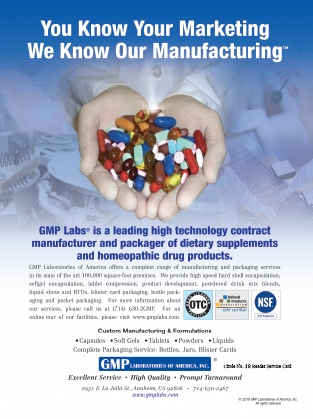 production-ready formula. Thus, formula development is integral to every relationship we engage.”
production-ready formula. Thus, formula development is integral to every relationship we engage.”
There are several ways contract manufacturers can fit into a product development plan.
Consider a step-by-step approach. Depending on the size and expertise of your staff, you may want to partner with a manufacturer that can walk you through the steps of product development. Israel says his company helps a finished product maker “maximize the likelihood of product success” with a few specific steps:
• Clearly identifying the target customer,
• Pinpointing the appropriate sales channel,
• Helping set a price point,
• Investigating desired activity and
• Discussing the product’s active ingredients.
“Once these basic questions are answered, ingredient selection, delivery system and formula development begin. A product proposition is created that includes a formula, testing requirements and a price model,” he states.
Eugene Ung, CEO of Best Formulations, City of Industry, CA, agrees that understanding the customer is the most important first step for product development. “We have to understand first what the customer is all about—their form of distribution, company philosophy and other product offerings. Certain formulas tend to sell better in a particular distribution channel…Once we understand the basics of our customer, coming up with formulation concepts is much easier as everyone is on the same page.”
After the baseline is set, contract manufacturers can help with ingredient selection and formula fine-tuning. For instance, they may check combination products for ingredients that will degrade or negatively affect another. For example, says Shabbir Akand, director of sales and marketing at NHK Laboratories, Inc., Santa Fe Springs, CA, “Coupling ascorbic acid with iron salts typically results in the formation of dark spots on tablets and capsules.”
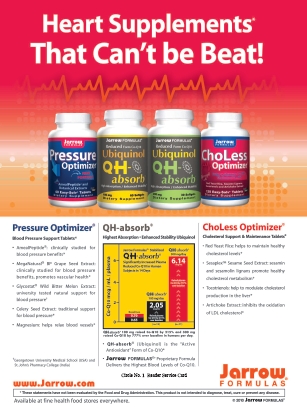 If this step-by-step approach appeals to you, you may be interested in the small-scale test options that some contract manufacturers offer. These may include the chance to try before you work on large batches. According to Shaheen Majeed, marketing director of Sabinsa, with U.S. headquarters in East Windsor, NJ and a contract manufacturing site in Payson, UT, “In many cases, we can show customers what the capsule or tablet may look like before going into full production. We have set up research and development and small-scale pilot plants to take trials and showcase the final product.”
If this step-by-step approach appeals to you, you may be interested in the small-scale test options that some contract manufacturers offer. These may include the chance to try before you work on large batches. According to Shaheen Majeed, marketing director of Sabinsa, with U.S. headquarters in East Windsor, NJ and a contract manufacturing site in Payson, UT, “In many cases, we can show customers what the capsule or tablet may look like before going into full production. We have set up research and development and small-scale pilot plants to take trials and showcase the final product.”
Take advantage of specializations. Some manufacturers can be a huge help in lending their expertise in a niche area. For instance, soft gel manufacturing can be tricky if you don’t have a knowledgeable partner. “Soft gelatin capsule formulation strategies have to consider the specific shell–fill interactions, which include chemical reactions of fill components with the gelatin and the plasticizer, and the migration of fill components in or through the shell and vice versa,” states Steve Holtby, president and CEO, Soft Gel Technologies, Inc., Los Angeles, CA. He notes that customers come to his firm for its soft gel expertise as well as formulating fragile or problematic ingredients.
Holtby also makes the point that several manufacturers, likehis, use proprietary techniques. So it’s important to know what you’re looking for in a manufacturer and to investigate all your options. A production method that may seem standard may, in fact, be available from just a handful of manufacturers.
An example, says Holtby, is that Soft Gel has patented methods for ensuring nutrient bioavailability. “Our R&D department is extremely skilled at determining the necessary quantities of oils to powders, along with suspending agents, etc., to make the best possible blends for a formulation,” he explains. 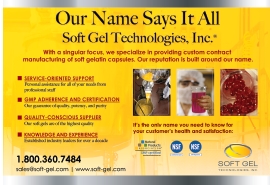
Save time and money. Last, formulation advice isn’t just about the ingredients. Since contract manufacturers know a thing or two about how manufacturing equipment functions best, they can use this expertise to optimize a product. Says Ung, “Being involved in the product development can help improve how the product runs on the machines to improve yield, quality and stability, and can help to reduce overall supply chain lead times.”
And, Akand notes that manufacturers can make suggestions about the appropriateness of a requested dosage form and serving size—both of which affect costs and profit. “Issues regarding unit price, blend density, ingredient hygroscopity, formulation stability and simple physics often dictate whether a formula requires a single tablet or capsule per serving, or several,” he states.
Again, these service offerings may not be standard across the board, so be sure to do your research to find the best match for your company’s needs.
Product Development from Square Two
Even if a finished product maker feels a formulation is final, there may still be some appropriate adjustments a contract manufacturer can make that will improve the end product. “There is a fair amount of consulting/ conversations that take place, even for well-established formulas,” adds Majeed, whose firm also has well-documented branded ingredients. “Because we know our products so well, we can provide significant guidance on how the materials will behave in manufacturing environments when they use our ingredients, saving a lot of trial and error in getting production up and running for a new product.”
Re-formulation advice may be especially necessary if the client is moving from one manufacturer to another. “Often a ‘formula’ is not always the same. What’s on a label may not be easy to replicate due to the proprietary know-how of the manufacturer; that is where a manufacturer with experience can cut many hours of research and development expense,” says Suhail Ishaq, president of GMP Laboratories of America, Anaheim, CA. He explains that a highly educated and knowledgeable contract staff can help reproduce such products while meeting quality standards and specifications.
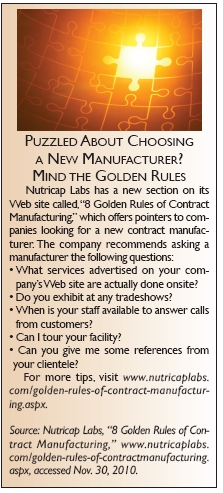 Noting the importance of a manufacturer’s specific expertise for formulation tweaking, Holtby uses soft gels as an example: soft gels aren’t ideal in every situation due to space limitations for the formula or interactions between raw materials. Both the physical and chemical properties of a formula must be analyzed, he feels. “Since we have extensive experience in developing formulations, we always try to work with our customers to help them understand the importance of choosing the appropriate delivery system; a product should always be manufactured to maximize its potential in a manner that fits within the end-user’s usage, lifestyle, and economic parameters. However, we do have to keep in mind that a custom formulation is the customer’s own, and they have often performed their own research in creating the formulation,” says Holtby.
Noting the importance of a manufacturer’s specific expertise for formulation tweaking, Holtby uses soft gels as an example: soft gels aren’t ideal in every situation due to space limitations for the formula or interactions between raw materials. Both the physical and chemical properties of a formula must be analyzed, he feels. “Since we have extensive experience in developing formulations, we always try to work with our customers to help them understand the importance of choosing the appropriate delivery system; a product should always be manufactured to maximize its potential in a manner that fits within the end-user’s usage, lifestyle, and economic parameters. However, we do have to keep in mind that a custom formulation is the customer’s own, and they have often performed their own research in creating the formulation,” says Holtby.
At the same time, not all formulas need a redo when starting new with a manufacturer. Says Jason Provenzano, president and founder of Nutricap Labs, Farmingdale, NY, “We are more than happy to give suggestions on how to improve an existing formula. However, we also advise the customer that if the formula isn’t broken, why try and fix it? People appreciate our honesty when it comes to that.” He states that his firm may, instead, point out a promotion or packaging problem or other trouble spot that may be hurting product sales.
Check, Please!
A manufacturer’s reputation is on the line when it comes to putting your product together. Thus, responsible firms are taking good manufacturing practices (GMPs) seriously and will verify the identity and purity of your raw materials. Though you are responsible for your end product, think of contract manufacturers as your final check for quality. “Our customers, who are selecting and purchasing the raw material for their supplements, realize it is their responsibility to ensure that the raw materials pass all tests for human consumption; they are responsible for all those rules and regulations, while we are responsible for the rules and regulations of manufacturing operations,” says Sunil Kohli, COO of Health Plus Inc., Chino, CA.
The challenge for the contract manufacturer is to verify materials in a thorough, responsible manner without holding up the production timeline. Thus, material requirements vary by manufacturer and by the product they are making.
For instance, some manufacturers just require certificates of analysis for ingredients and will only conduct their own testing if something looks suspicious. Others take things a step further by automatically testing materials. At manufacturers like Sabinsa, all raw materials are tested for identity and purity before making a finished product, says Majeed.
Similarly at GMP Laboratories of America, “We perform identification of all incoming raw materials through Fourier transform near infrared (FTNIR) technology. Assay analysis is carried out by highperformance liquid chromatography (HPLC). We have a separate microbiology lab where we perform standard microbes and pathogens testing,” states Ishaq.
Israel adds that his company conducts similar identity, purity and potency testing and refuses to use anything that isn’t genuine and valid. He states, “Ingredients provided to us must be legitimate dietary supplement ingredients. We avoid substances that are not either an old dietary ingredient or a material with a successful new dietary ingredient petition. While the client is responsible for what they sell, we know that a customer-supplied ingredient can impact our reputation, thus we take steps to ensure the quality of all of the products that we manufacture.”
In the end, not all manufacturers will accept even certain legitimate raw materials. Rather than risk contamination, All American Pharmaceutical, Billings, MT, won’t work within materials from clients (unless it is specifically made for or by them). Says Joe Archer, the company’s vice president of sales and marketing, “We have found over the years that a very high percentage of the client supplied materials do not pass our quality control standards and cannot be brought into the facility. With All American being an Informed Choice facility, the risk of contamination is not a risk that we are willing to take.” He also feels that supplying raw materials for clients is more cost-effective in the long run, too.
According to Akand, some manufacturers (like his firm) pre-approve certain raw material suppliers and will only work with companies that will source ingredients from their list of qualified suppliers. Even when clients work from this list, “we require that our clients provide documentation confirming the ingredients’ identity,purity, and potency from the qualified supplier,” he states.
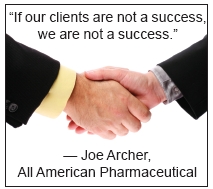 GMP upgrades. Now that the GMPs for dietary supplements are in place, contract manufacturers (through efforts at their site) can help ensure you are in compliance with the regulations. Since the rules have been enacted, several manufacturers have made headway optimizing their compliance.
GMP upgrades. Now that the GMPs for dietary supplements are in place, contract manufacturers (through efforts at their site) can help ensure you are in compliance with the regulations. Since the rules have been enacted, several manufacturers have made headway optimizing their compliance.
Says Ung, “Currently, contract manufacturers are spending the bulk of their time with GMP compliance rather than new technology development.”
Here are a few recent upgrades at industry contract manufacturers:
• All American Pharmaceutical, says Archer, is now an Informed Choice certified facility and the company is getting ready to break ground on phase one of its next expansion.
• GMP Laboratories of America, Inc. streamlined its processes to comply with the new GMPs and equipped its lab with FTNIR to test all incoming raw materials, according to Ishaq. He states, “Additionally, we have increased the number of lab equipment such as viscosity, pH, conductivity, TDS and resistivity meters to perform all of our testing in-house.”
• Nutricap Labs recently opened a new facility and added several machines to help increase its manufacturing capacity.
• Robinson Pharma has invested over $2 million in new laboratory infrastructure over the past year including major equipment upgrades, says Israel. “We have also expanded our quality team to over 40 people (we are fully staffed) and we have new leadership including Ph.D. level technical staff positions,” he notes.
Out the Door: Boosting Shelf Appeal
Before a formulation heads out the door, many contract manufacturers help clients to get their products aesthetically spruced up so that shoppers will be drawn to an attractive product. Packaging and labeling personnel may be on hand with some important advice. Says Provenzano, “If you don’t have the proper packaging solution or an eye-catching label that’s going to grab a person’s attention when they see it on a shelf, then you’re never going to sell your product— no matter how effective it might be.”
Box it up! On the packaging front, one may assume that eco-friendly offerings are abundant and in demand. Unfortunately, several of the manufacturers contacted for this piece say the opposite is true. One firm states that though there’s some interest in green labels and packaging, many finished product makers end up choosing less expensive (and less eco-friendly options). While it is not the case for all brands, the manufacturer feels “our industry as a whole seems to be ‘late adopters’ in terms of trends, generally speaking. Although being green is the latest buzz (and the right thing to do, quite frankly), we have not seen much interest in eco-friendly packaging.” The reason why, the company believes, is that green turns one’s bottom line red: “Unfortunately, we have not been able to get eco-friendly packaging costs down to where it’s competitive with regular packaging.”
In agreement is another manufacturer who states that few of its clients have adopted green packaging. Customers and stores are stating their packaging preferences with their dollars, and “the message is that traditional packaging is preferred and that price point is more important,” the company feels.
 A third contract manufacturer puts the situation into greater perspective: “When we attend tradeshows, I typically have one person out of hundreds or thousands that inquires about it and during a typical month, I would say our sales representatives field maybe two or three calls about it. The biggest ‘deal breaker’ when it comes to this kind of packaging is the cost that’s associated with it…as a result, people opt to stick with traditional jars, bottles, packets, etc.”
A third contract manufacturer puts the situation into greater perspective: “When we attend tradeshows, I typically have one person out of hundreds or thousands that inquires about it and during a typical month, I would say our sales representatives field maybe two or three calls about it. The biggest ‘deal breaker’ when it comes to this kind of packaging is the cost that’s associated with it…as a result, people opt to stick with traditional jars, bottles, packets, etc.”
But there has been some movement in demand for green packaging by leading mass market retailers, says Israel, on their private brands and in their supply network. “These retailers have been developing and implementing measures of product total carbon footprint, benchmarking current vendor performance and demanding improvement. These practices are impacting all aspects of the product supply chain and this systematic approach may ultimately yield greater benefit than merely changing the type of bottle or label that a product appears in,” he believes, adding, “Perhaps, the adoption of green practices by these largest players will develop economies of scale and tested technologies that can be translated into smaller organizations.”
Green-minded manufacturers, don’t let this slow adoption discourage you. If you’re interested in eco-friendly 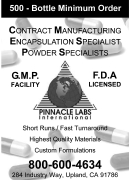 packaging, several contract manufacturers are keeping their eye on new developments in this area and are prepared to help you make smart, green packaging choices.
packaging, several contract manufacturers are keeping their eye on new developments in this area and are prepared to help you make smart, green packaging choices.
For instance, Technigraph, a division of Alpha Packaging, St. Louis, MO, has a new eco-friendly spray frost (called Eco-Frost) that can be applied to bottles in lieu of labels. This technology has been commercially available since the summer of 2010. Often used in conjunction with other forms of screen printing, “Eco-Frost doesn’t have any volatile organic compounds, heavy metals or solvents that cause it to dry,” says Marny Bielefeldt, marketing manager. Instead, it’s cured using a UV light, which Bielefeldt says is much safer than other frosting techniques for the workers and for the environment. Traditional spray frost is so hard on the environment, that it has strict manufacturing rules outlined by the Environmental Protection Agency. In contrast, Alpha Packaging’s eco-friendly inks can be tinted or frosted in a variety of different hues, finishes and opacities; the end result is a unique, fully recyclable bottle.
Other unique options come from Label Impressions, Inc., Orange, CA, which offers eco-friendly labels made of such materials as stone, corn and post-consumer waste. Additional green materials from Label Impressions include plant-based adhesives, soy inks and water-based inks.
Israel states he is excited about the possibility of using eco-friendly pouches and resealable bags in lieu of bottles for certain dosage forms. He also notes that other interesting green options include post-consumer recycled packaging components, non-paper labels, and “rightsizing” of packaging.
Adjusting the sizing of your packaging is something with which many contract manufacturers regularly help clients. Using smaller bottles, for instance, is a fairly simple and costeffective way for finished product makers to reduce their carbon footprint. But, it does require some buy-in for the brand’s marketers. Says Ung, “For direct-to-consumer companies (such as multi-level marketing, mail order and Internet companies), this is much easier to accomplish. But, products in the retail and mass market need to stand out and, therefore, packaging size increases.”
It’s a wrap. What marketers say about a product via the label is another way that manufacturers can offer a helping hand. Some manufacturers feel the language on labels is entirely the customers’ responsibility. However, they do often try to reign in clients that may have gone astray with overzealous product claims. For instance, Kohli of Health Plus states, “If we see anything questionable, we do feel it appropriate to apprise our customer that he/she may want to double-check the language, just to be on the safe side. It is not our place to tell our customers what to do, but to fulfill their requests to the best of our abilities and to achieve the consistency of runs they require for their consumers.”
Many manufacturers flat-out won’t send a dubious product out their doors. Their reputations are, in part, reflections of the finished products that end up on store shelves, and many high-quality manufacturers feel working with an unscrupulous marketer isn’t worth the money. Thus, many firms review their clients’ label claims and take action, if necessary.
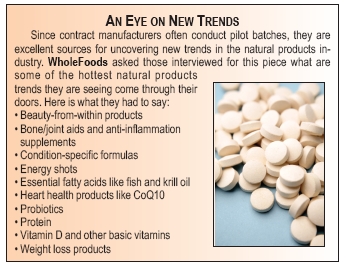 Says Majeed, “We have an in-house regulatory department that can assist in what a label should and shouldn’t say. Often times the customer would like to mention something, which goes beyond our dietary supplement industry regulatory guidelines, and at that point we would advise the customer on the appropriate language to use.” If customers don’t comply with Federal Trade Commission (FTC)/U.S. Food and Drug Administration (FDA) labeling guidelines, “we simply will not manufacture the product for them,” he states.
Says Majeed, “We have an in-house regulatory department that can assist in what a label should and shouldn’t say. Often times the customer would like to mention something, which goes beyond our dietary supplement industry regulatory guidelines, and at that point we would advise the customer on the appropriate language to use.” If customers don’t comply with Federal Trade Commission (FTC)/U.S. Food and Drug Administration (FDA) labeling guidelines, “we simply will not manufacture the product for them,” he states.
NHK Laboratories has a similar take on the situation. Says Akand, “A good label is consistent with the brand’s image that clearly communicates the product’s purpose while complying with FDA and FTC regulations…If a product has a questionable structure– function claim, we notify our clients immediately and work with them to achieve compliance.”
Health Plus actually vets it clients. “We will never take on a job just to make money. We are not interested in fly-by-night products that skirt the FDA or may actually harm consumers,” says Kohli.
As for the aesthetics, Nutricap Labs’ Provenzano makes the point that the best-looking labels really depend on the type of product. He explains that a bodybuilding supplement may warrant bold fonts and colors while a beauty care item may have a “clean” label design with softer, sophisticated fonts. Ultimately, he says, “the design of the label needs to grab the eye of the customer when they see it on a shelf and it should clearly state the benefits that they’ll receive from taking the product.”
Ung adds that a good label design serves a marketer well when it is clear and informative. “The customer should pick up the bottle and within three seconds know what the product is,” he says. WF
Published in WholeFoods Magazine, January 2011

